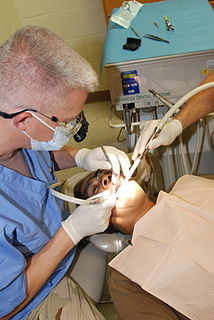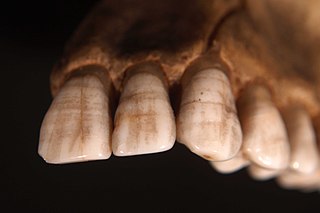Related Research Articles

Dentistry, also known as dental medicine and oral medicine, is a branch of medicine that consists of the study, diagnosis, prevention, and treatment of diseases, disorders, and conditions of the oral cavity, commonly in the dentition but also the oral mucosa, and of adjacent and related structures and tissues, particularly in the maxillofacial area. Although primarily associated with teeth among the general public, the field of dentistry or dental medicine is not limited to teeth but includes other aspects of the craniofacial complex including the temporomandibular joint and other supporting, muscular, lymphatic, nervous, vascular, and anatomical structures.

Dentition pertains to the development of teeth and their arrangement in the mouth. In particular, it is the characteristic arrangement, kind, and number of teeth in a given species at a given age. That is, the number, type, and morpho-physiology of the teeth of an animal.

A toothbrush is an oral hygiene instrument used to clean the teeth, gums, and tongue. It consists of a head of tightly clustered bristles, atop of which toothpaste can be applied, mounted on a handle which facilitates the cleaning of hard-to-reach areas of the mouth. They are usually used alongside floss.

Tooth decay, also known as dental caries or cavities, is the breakdown of teeth due to acids made by bacteria. The cavities may be a number of different colors from yellow to black. Symptoms may include pain and difficulty with eating. Complications may include inflammation of the tissue around the tooth, tooth loss, and infection or abscess formation.

A dental implant is a surgical component that interfaces with the bone of the jaw or skull to support a dental prosthesis such as a crown, bridge, denture, facial prosthesis or to act as an orthodontic anchor. The basis for modern dental implants is a biologic process called osseointegration, in which materials such as titanium form an intimate bond to bone. The implant fixture is first placed so that it is likely to osseointegrate, then a dental prosthetic is added. A variable amount of healing time is required for osseointegration before either the dental prosthetic is attached to the implant or an abutment is placed which will hold a dental prosthetic/crown.

The cusp of Carabelli, or Carabelli's tubercle, or tuberculum anomale of Georg Carabelli is a small additional cusp at the mesiopalatal line angle of maxillary first molars. This extra cusp is usually found on the first molar, and becomes progressively less likely in the second, third molars. This cusp is entirely absent in some individuals and present in others in a variety of forms. In some cases, the cusp of Carabelli may rival the main cusps in size. Other related forms include ridges, pits, or furrows. This additional cusp was first described in 1842 by the Hungarian Georg Carabelli, the court dentist of the Austrian Emperor Franz.
Perikymata are incremental growth lines that appear on the surface of tooth enamel as a series of linear grooves. In anatomically modern humans, each perikyma takes approximately 6–12 days to form. Thus, the count of perikymata may be used to assess how long a tooth crown took to form. They may disappear as the enamel wears over time after the tooth erupts.
A glass ionomer cement (GIC) is a dental restorative material used in dentistry as a filling material and luting cement, including for orthodontic bracket attachment. Glass-ionomer cements are based on the reaction of silicate glass-powder and polyacrylic acid, an ionomer. Occasionally water is used instead of an acid, altering the properties of the material and its uses. This reaction produces a powdered cement of glass particles surrounded by matrix of fluoride elements and is known chemically as glass polyalkenoate. There are other forms of similar reactions which can take place, for example, when using an aqueous solution of acrylic/itaconic copolymer with tartaric acid, this results in a glass-ionomer in liquid form. An aqueous solution of maleic acid polymer or maleic/acrylic copolymer with tartaric acid can also be used to form a glass-ionomer in liquid form. Tartaric acid plays a significant part in controlling the setting characteristics of the material. Glass-ionomer based hybrids incorporate another dental material, for example resin-modified glass ionomer cements (RMGIC) and compomers.
Dens evaginatus is a rare odontogenic developmental anomaly that is found in teeth where the outer surface appears to form an extra bump or cusp.

Shovel-shaped incisors are incisors whose lingual surfaces are scooped as a consequence of lingual marginal ridges, crown curvature or basal tubercles, either alone or in combination.

Talon Cusp is a rare dental anomaly. Generally a person with this develops "cusp-like" projections located on the inside surface of the affected tooth. Talon cusp is an extra cusp on an anterior tooth. Although talon cusp may not appear serious, it can cause clinical, diagnostic, functional problems and alters the aesthetic appeal.
Simon Hullihen MD, DDS was a dental surgeon born in Point Township, Northumberland County, Pennsylvania. He completed his medical degree and then was inspired to seek a career in oral and maxillofacial surgery. Regarded as the first oral surgeon in the United States, he helped to develop many modern techniques of maxillofacial surgery and contributed to the establishment of oral and maxillofacial surgery as a surgical specialty.

The sloth lemurs (Palaeopropithecidae) comprise an extinct clade of lemurs that includes four genera. The common name can be misleading, as members of Palaeopropithecidae were not closely related to sloths. This clade has been dubbed the ‘‘sloth lemurs’’ because of remarkable postcranial convergences with South American sloths. Despite postcranial similarities, the hands and feet show significant differences. Sloths possess long, curved claws, while sloth lemurs have short, flat nails on their distal phalanges like most primates.

Enamel hypoplasia is a defect of the teeth in which the enamel is deficient in amount, caused by defective enamel matrix formation. Defects are commonly split into one of four categories, pit-form, plane-form, linear-form, and localised enamel hypoplasia. In many cases the enamel crown has pits or a groove on it, and in extreme cases, sections of the tooth have no enamel, exposing the dentin. Enamel hypoplasia varies substantially among populations and can be used to infer health and behaviour in past populations. Defects have also been found in a variety of non-human animals.
The infundibulum of a tooth is the funnel-like center that is filled with cementum. The funnel is widest at the top (crown) which is the grinding (occlusal) surface. The infundibulum is also known as the dental cup. Simple tooth infundibula occur most notably in the incisors of horses and other equines, but they also occur in the premolars and molars of ruminants: camels, deer, horses and all bovids. The infundibula found in ruminants can get quite complex some with two funneling centers, and with multiple folding in the sides of the cup. These folds produce greater amounts of enamel in vertical curtains that substantially increase the durability of the tooth. The cheek teeth of elephants express this in a slightly different form with the vertical curtains of enamel coming in from the sides and meeting in the middle.

Tooth wear refers to loss of tooth substance by means other than dental caries. Tooth wear is a very common condition that occurs in approximately 97% of the population. This is a normal physiological process occurring throughout life; but with increasing lifespan of individuals and increasing retention of teeth for life, the incidence of non-carious tooth surface loss has also shown a rise. Tooth wear varies substantially between people and groups, with extreme attrition and enamel fractures common in archaeological samples, and erosion more common today.
Peter H. Buschang is an anthropologist, an orthodontic researcher and an orthodontic educator. He is also an honorary member of American Association of Orthodontics and Edward H. Angle Society of Orthodontists.
Rafiuddin Ahmed was an Indian dentist, educator and later minister in the West Bengal cabinet, who founded the first dental college of India, Dr. R. Ahmed Dental College and Hospital, later named 'The Calcutta Dental College', where he remained its principal until 1950. He established the Indian Dental Journal in 1925, and played a key role in founding the Bengal Dentist Act in 1939. In 1946, he established The Bengal Dental Association which was then renamed as the Indian Dental Association. The Government of India awarded him the Padma Bhushan in 1964.

Linear enamel hypoplasia is a failure of the tooth enamel to develop correctly during growth, leaving bands of reduced enamel on a tooth surface. It is the most common type of enamel hypoplasia reported in clinical and archaeological samples, with other types including plane-form enamel hypoplasia and pitting enamel hypoplasia.
Anterior teeth are one of the most scrutinized teeth, the size and shape and color of the anterior upper teeth plays an important role in dental aesthetics and smile aesthetics. A few aesthetic anterior problems could be solved with composite restorations. For example, dental caries, tooth fracture, enamel defects and diastemas. Composite restoration can also improve aesthetic by changing shape, color, length and alignment of teeth.
References
- ↑ Am J Phys Anthropol. 2011 Feb;144(2):204-14. doi: 10.1002/ajpa.21386. Epub 2010 Aug 25.
- ↑ Van Beek, Geoffrey (2008). Dental Morphology, An Illustrated Guide. Wright. pp. 30, 33. ISBN 9780723606666.
- ↑ Dental Anthropology Simon Hillson p.67 ISBN 0-521-45194-9
- ↑ The Juvenile Skeleton p.161 ISBN 0121028216
- ↑ A Dictionary of Dentistry (Oxford Quick Reference) ISBN 0199533016
- ↑ Hillson, Simon (1996). Dental Anthropology by Simon Hillson. doi:10.1017/cbo9781139170697. ISBN 9781139170697.
- ↑ Rai, Balwant; Kaur, Jasdeep (2013-01-01). Evidence-Based Forensic Dentistry. Springer Berlin Heidelberg. pp. 81–85. doi:10.1007/978-3-642-28994-1_6. ISBN 9783642289934.
| This dentistry article is a stub. You can help Wikipedia by expanding it. |